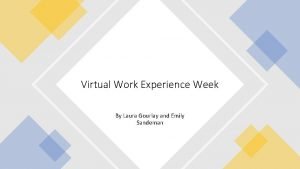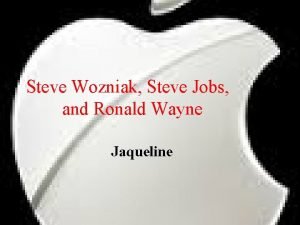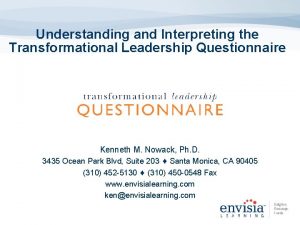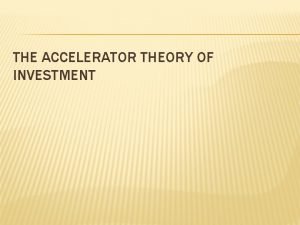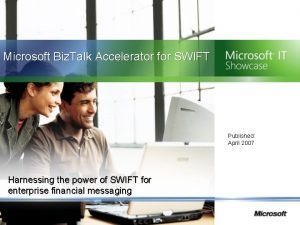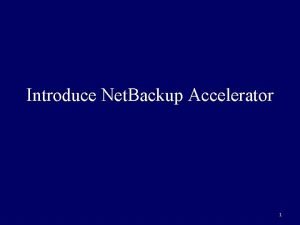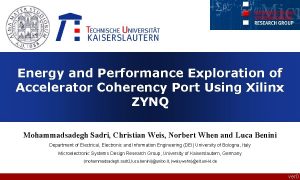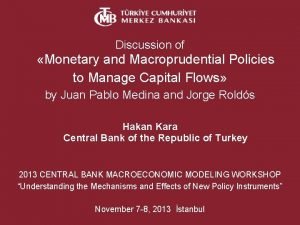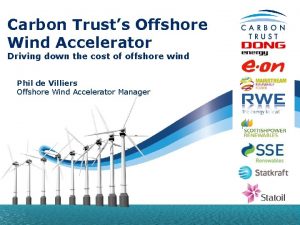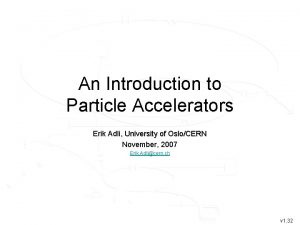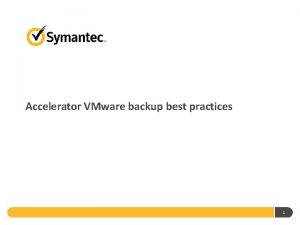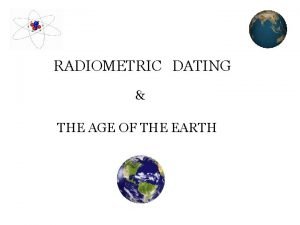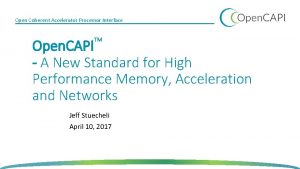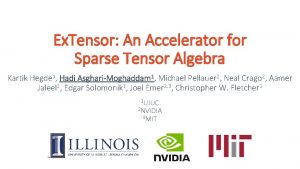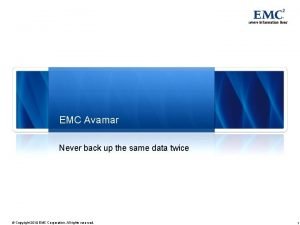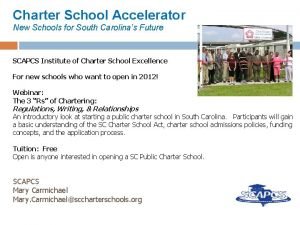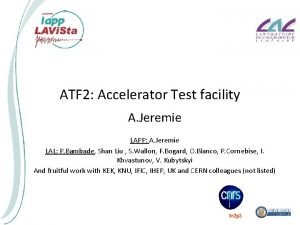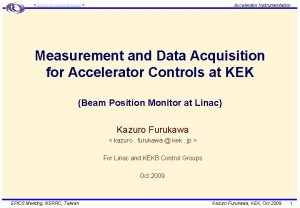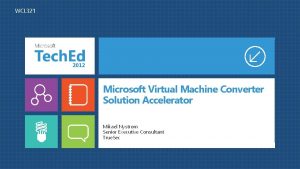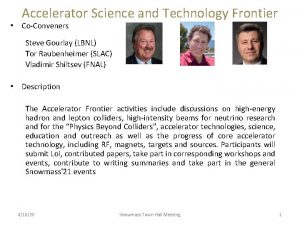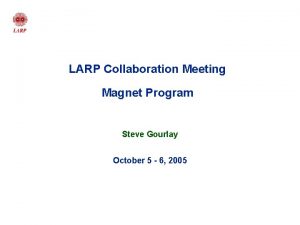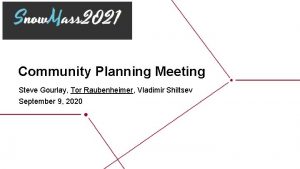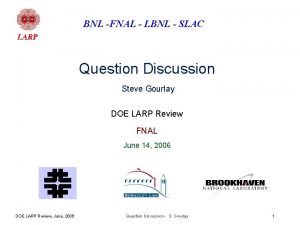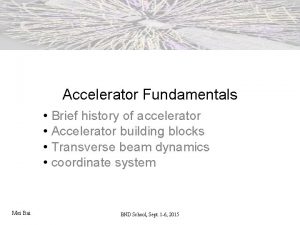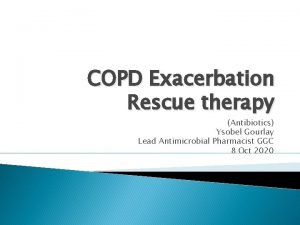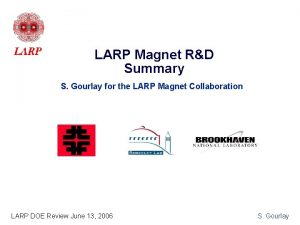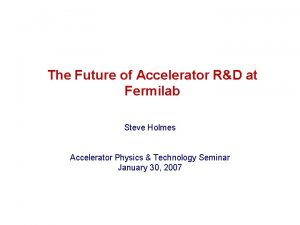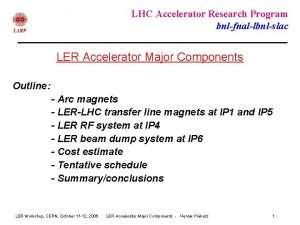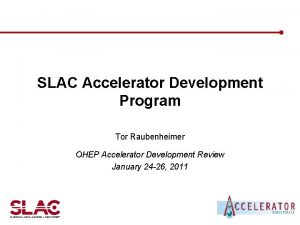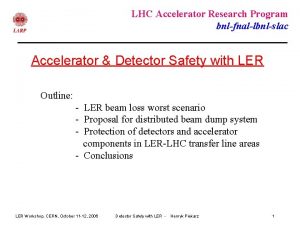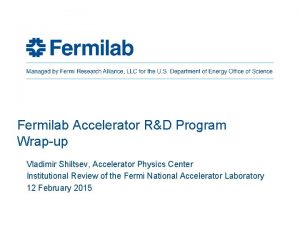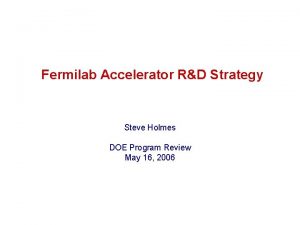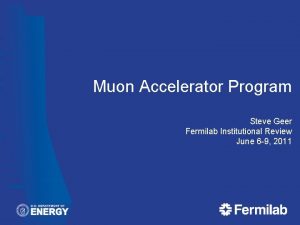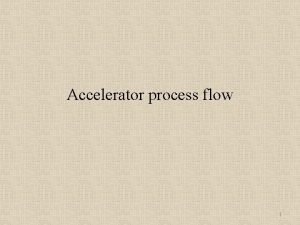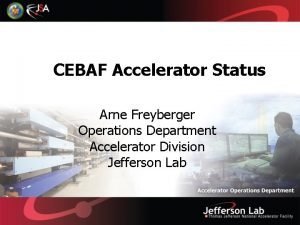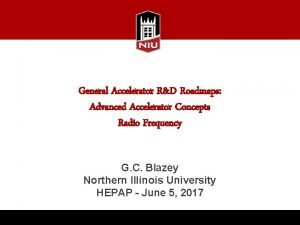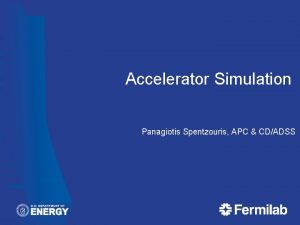US Future Program for Accelerator RD Steve Gourlay
































- Slides: 32

US Future Program for Accelerator R&D Steve Gourlay for the High Energy Physics Advisory Panel (HEPAP) Subpanel on Accelerator R&D Hi-Lumi Collaboration Meeting 11/2014 1

DOE/SC Organization chart 2

HEP Organization chart where accelerator budget lines reside 3

P 5 Highlights Hi-Lumi Collaboration Meeting 11/2014 4

Science Drivers • Use the Higgs boson as a new tool for discovery – LHC and HL-LHC – e+e- collider – Future generation accelerators • Pursue the physics associated with neutrino mass – Long Baseline Neutrino Facility (LBNF) – PIP-II • Identify the new physics of dark matter • Understand cosmic acceleration: dark energy and inflation • Explore the unknown: new particles, interactions, and physical principles – HL-LHC – Mu 2 e – Very high-energy e+e- colliders and very high-energy proton colliders Hi-Lumi Collaboration Meeting 11/2014 5

Enabling R&D • Advances in accelerators, instrumentation, and computing are necessary to enable the pursuit of the Drivers. Greater demands are being placed on the performance in all three areas, at reduced cost, necessitating continued investments in R&D. • The DOE General Accelerator R&D (GARD) program and Accelerator R&D Stewardship program, as well as the new NSF Basic Accelerator Science program, form the critical basis for both long- and short-term accelerator R&D, enriching particle physics and other fields. Hi-Lumi Collaboration Meeting 11/2014 6

GARD Subpanel • Recommendation 26: Pursue accelerator R&D with high priority at levels consistent with budget constraints. Align the present R&D program with the P 5 priorities and longterm vision, with an appropriate balance among general R&D, directed R&D, and accelerator test facilities and among short-, medium-, and long-term efforts. Focus on outcomes and capabilities that will dramatically improve cost effectiveness for mid-term and far-term accelerators. • A HEPAP subcommittee on accelerator R&D will provide detailed guidance on the implementation of accelerator R&D aligned with P 5 priorities. Hi-Lumi Collaboration Meeting 11/2014 7

Subpanel Members Bill Barletta MIT Young-Kee Kim U of Chicago Ilan Ben-Zvi BNL& Stonybrook Tadashi Koseki KEK/J-PARC Marty Breidenbach SLAC Geoff Kraft (NP) JLAB Oliver Bruning CERN Andy Lankford UC Irvine Bruce Carlsten Los Alamos Lia Merminga Triumf Roger Dixon Fermilab Jamie Rosenzweig UCLA Steve Gourlay LBNL Mike Syphers MSU Don Hartill (Chair) Cornell Bob Tschirhart Fermilab Georg Hoffstaetter Cornell Rik Yoshida Argonne Zhirong Huang (BES) SLAC Hi-Lumi Collaboration Meeting 11/2014 8

Charge Summary National Goals: Appropriate goals in broad terms for medium ( < 10 years ) and long term ( < 20 years ) U. S. Accelerator R&D for a world leading future program in accelerator based particle physics consistent with P 5 Current Effort: Examine the scope of the current effort and evaluate how well these address the HEP mission as expressed by P 5 Impediments: Describe any impediments that may exist in achieving these goals Hi-Lumi Collaboration Meeting 11/2014 9

Charge Summary Training: Accelerator R&D efforts play a major role in training future accelerator scientists and technologists. How are we doing? Balance: How do we maintain a healthy and appropriately balanced national program? Provide further guidance for a plan based on the science and technology case for increased investment in HEP Accelerator R&D called for in P 5’s Scenario C Hi-Lumi Collaboration Meeting 11/2014 10

Information Gathering Meetings were held at BNL, Fermilab, Argonne, SLAC and LBNL. Subpanel Website: http: //www. usparticlephysics. org/p 5/ards Website has the agendas and the talks for the lab visits. Town Hall meetings were held at each of the lab visits. Hi-Lumi Collaboration Meeting 11/2014 11

Meetings First Meeting (Organizational) at SLAC July 7 & 8. Road Trip to BNL, Fermilab & Argonne, and SLAC & LBNL week of August 25 to 30. Two Day Meeting Newport Beach, CA Nov. 6 & 7 Final Two Day Meeting Chicago, IL Dec. 3 & 4 Hi-Lumi Collaboration Meeting 11/2014 12

Road Trip Energy frontier was the focus at BNL. Intensity frontier was the topic at Fermilab. Novel Particle Acceleration was theme at SLAC/LBNL. Two hour executive session at LBNL followed by a two page report by each subpanel member on their impressions from the road trip. Hi-Lumi Collaboration Meeting 11/2014 13

Current GARD Program • In FY 14 the General Accelerator Research and Development budget was 85. 5 M$ • Includes HEP Directed Accelerator R&D (LARP and MAP), and is exclusive of the Office of Science (SC) Accelerator R&D Stewardship program. Since the P 5 report, 26 M$ of SRF R&D at Fermilab has been redirected to the PIP II project and test facility operation support. Also included in the GARD program is 12 M$ for wakefield acceleration operations and 5 M$ for superconducting magnet facility operating costs. This leaves a net of 42. 5 M$ for GARD base programs and is divided among the seven GARD thrusts and is illustrated by the following chart: Hi-Lumi Collaboration Meeting 11/2014 14

Current GARD Program Hi-Lumi Collaboration Meeting 11/2014 15

NSF Program in Accelerator Science In addition to the DOE GARD program, NSF has started their new program in Accelerator Science with a total funding level of 9. 8 M$ this year. Fourteen awards have been made covering a broad range of topics in Accelerator Science. It is a very welcome addition to the NSF portfolio. Hi-Lumi Collaboration Meeting 11/2014 16

Future Collider Options An ILC in Japan is under study. Muon colliders were not endorsed by P 5. The Future Circular Collider collaboration meeting was held earlier this year. The URL for all the talks is https: //indico. cern. ch/event/333236/other-view? view=standard FCC R&D is now part of the CERN medium term plan and they have applied for H 2020 funding to support some of the R&D. More than 25 institutions have signed MOU’s to carry out different parts of the needed R&D. The FCC could initially be a ~ 200 Ge. V e+e- collider or a ~ 100 Te. V pp collider. Hi-Lumi Collaboration Meeting 11/2014 17

Future Collider Options The high energy physics community in China is pressing forward with a proposal for a 50 to 80 km ring. It would first be a ~ 200 Ge. V e+e- collider with a proposed construction start in the early 2020’s followed by a pp collider in the mid 2030’s. In addition, there is a 150 MEuro EU initiative spread over ten years in laser plasma acceleration with a focus on developing compact synchrotron radiation sources including FELs. Hi-Lumi Collaboration Meeting 11/2014 18

US GARD Opportunities For the Intensity Frontier, the measure is MW • Ktons • beamtime/yr so accommodating higher beam power has significant leverage. Beam stability at synchrotron injection energies combined with higher power targets could have large benefits. Future high energy colliders are expensive. Optimization studies will be key in lowering the cost and maximizing operating efficiency. Optimized superconducting magnet design both in field and manufacturablity will require R&D. For e+e-, more efficient RF would lower operating costs. Advanced acceleration technology potentially has the promise of dramatically increasing the accelerating gradient and thereby significantly reducing the cost of a very high energy accelerator or collider. Hi-Lumi Collaboration Meeting 11/2014 19

Subpanel Challenges The Accelerator R&D Subpanel is not a project review panel. Our task is to recommend a balanced program in accelerator R&D to OHEP to provide the US with a world leading program in accelerator based particle physics. And, parenthetically developing an exciting program that will attract additional funding to the program. We were briefed on several initiatives each with a price tag of ~ 25 M$ per year including capital investment, operations, and experiments. One on-going program will stop at the end of FY 16 unless a significant investment is made to reconfigure a portion of the SLAC linac because of the LCLS II construction project. Hi-Lumi Collaboration Meeting 11/2014 20

Subpanel Challenges To make a contribution to future high energy colliders, the superconducting magnet program will need increased investment both in going to higher magnetic fields and in developing manufacturing techniques that significantly reduce the magnet assembly labor costs. For the LCLS II cryomodules, the cost of Nb for the cavities is only 10% of the cost, so improved manufacturing techniques have the potential of significantly reducing the cost of the completed cryomodules for a high energy SRF based collider. Hi-Lumi Collaboration Meeting 11/2014 21

Process After the Road Trip we have set up the following six accelerator R&D areas to study in more detail: Accelerator physics computation and simulation: Advanced acceleration: Normal conducting RF structures and sources Wakefield accelerators Beam driven plasma wakefield acceleration Laser driven plasma wakefield acceleration Dielectric laser acceleration Fundamental aspects of muon acceleration Hi-Lumi Collaboration Meeting 11/2014 22

Process Beam dynamics, instrumentation and controls: Space charge dominated beams Timing systems, beam controls, beam loss monitoring, etc. Similar activities at universities Particle Sources and Targets: High power beams, horns, targets, and collimators Beam dumps Superconducting Magnets and Materials: Superconducting RF: Hi-Lumi Collaboration Meeting 11/2014 23

Process The R&D needs for future very high energy colliders will be covered in the six areas mentioned previously rather than setting up a separate area. High field superconducting magnets, beam dynamics and instrumentation, along with efficient RF acceleration are the key areas. To make sure everything is included, a separate list of needed R&D will be maintained for these very high energy colliders. Hi-Lumi Collaboration Meeting 11/2014 24

Process Each area has at least two subpanel members assessing the information provided to the subpanel and developing appropriate guidance and recommendations. Good progress is being made by each of these subgroups and preliminary draft reports are being written by each subgroup. Some early drafts have already been produced. Discussion between the subgroups takes place during our weekly telecons. Hi-Lumi Collaboration Meeting 11/2014 25

Process Written comments were accepted on the subpanel website until October 17. Draft reports from each subgroup were discussed at the November 6, 7 meeting and are being assembled into a very preliminary draft report. Refinement of the report will be done through frequent teleconferences. Hi-Lumi Collaboration Meeting 11/2014 26

P 5 is very supportive of superconducting magnet R&D “The HL-LHC is strongly supported and is the first high-priority large-category project in our recommended program. ” “The U. S. also contributed critical components. . . the construction of the LHC accelerators. Similarly, the experiments and accelerator upgrades cannot occur without the unique U. S. technical capabilities (e. g. , the high-field magnets necessary for the success of the project) and resources. ” “Going much further, however, requires changing the capability-cost curve of accelerators , which can only happen with an aggressive, sustained, and imaginative R&D program. ” “Primary goal, . . build the future-generation accelerators at dramatically lower cost. For, example, the primary enabling technology for pp colliders is high-field accelerator magnets, . . . ” “The U. S. is the world leader in R&D on high-field superconducting magnet technology, . . ” “Strengthen national laboratory-university R&D partnerships, leveraging their diverse expertise and facilities. ”

Community Input • Mc. Intyre (TAMU) – Inexpensive 4. 5 T magnets for large ring • Palmer (BNL) – Optimum magnet field 8 – 10 T • Prestemon (representing US program) – Aggressive conductor development – Emphasize magnet “science” – Significant potential for performance improvement and cost reduction requires multi-prong effort • Shiltsev (FNAL) – SC magnet technology guarantees the energy frontier – Address feasibility of acceptable cost – Explore cost/performance trade-offs – Coordinate with global design studies Hi-Lumi Collaboration Meeting 11/2014 28

Community Input • Apollinari (LARP) – LARP benefited from synergy with GARD activities – Emphasized the need for LARP 2 to continue R&D activities and support HL-LHC • Nagaitsev (FNAL) – High-field magnets and materials are Fermilab’s highest GARD priority – Significant T*m cost reduction, modest support of global design • Eichorn (Cornell) – Increased interest in Bi-2212 – Three possible conductors • New and very much improved Nb 3 Sn • Further developed Bi-2212 round wire • Cable-friendly REBCO • Boudry (CERN) – HTS complementary to LTS but unlikely to displace it – Focus on Nb 3 Sn (affordability, performance, collider-ready) Hi-Lumi Collaboration Meeting 11/2014 29

Community Input • Joint Whitepaper from BNL, FNAL, LBNL, FSU/NHMFL – Calls for creation of US National Program coordinated with international efforts to support P 5 priorities (100 Te. V pp) • The Program aims at the following goals: Goal 1: Develop accelerator magnets at the limit of Nb 3 Sn capabilities. This is presently believed to be approximately 16 T. Goal 2: Explore LTS accelerator magnets with HTS inserts for fields beyond the Nb 3 Sn capabilities. The present target is 20 T or above. Goal 3: Drive high-field conductor development, both Nb 3 Sn and HTS materials, for accelerator magnets. Goal 4: Address fundamental aspects of magnet design, technology and performance that could lead to substantial reduction of magnet cost. Hi-Lumi Collaboration Meeting 11/2014 30

Conclusions for Magnets • Subpanel (and the community as well) is supportive of Superconducting Magnet R&D • Calls for transformative R&D • Cost reduction (from P 5) is high priority Hi-Lumi Collaboration Meeting 11/2014 31

General Conclusions A healthy program in accelerator R&D is key to insuring that the US accelerator based high energy particle physics program is world leading. Training of the next generation of accelerator scientists and technologists is a very important element of this R&D program. See the HEPAP Subpanel report on personnel needs published this past spring. Our hope is that our report will provide useful guidance to DOE OHEP in charting the future of accelerator R&D in the US. Hi-Lumi Collaboration Meeting 11/2014 32
 Laura gourlay
Laura gourlay By the time future perfect
By the time future perfect Future perfect e future continuous
Future perfect e future continuous Talent accelerator program
Talent accelerator program Steve jobs steve wozniak ronald wayne
Steve jobs steve wozniak ronald wayne The perfect future tense
The perfect future tense Past future tense
Past future tense Future continuous future perfect exercises
Future continuous future perfect exercises Future nurse programme
Future nurse programme Past future continuous
Past future continuous Present continuous for plans
Present continuous for plans Perfect infinitive
Perfect infinitive Future plans and finished future actions
Future plans and finished future actions Future perfect future perfect continuous
Future perfect future perfect continuous Nulti kondicional
Nulti kondicional Transformational leadership questionnaire tlq
Transformational leadership questionnaire tlq Limitations of accelerator theory of investment
Limitations of accelerator theory of investment Biztalk swift
Biztalk swift Netbackup accelerator
Netbackup accelerator Fiscal policy ib definition
Fiscal policy ib definition Accelerator coherency port
Accelerator coherency port Financial accelerator
Financial accelerator Offshore wind accelerator
Offshore wind accelerator Proton
Proton Netbackup vmware backup process flow
Netbackup vmware backup process flow Accelerator mass spectrometry
Accelerator mass spectrometry Open capi
Open capi Extensor: an accelerator for sparse tensor algebra
Extensor: an accelerator for sparse tensor algebra Avamar overview
Avamar overview Charter network accelerator
Charter network accelerator Accelerator
Accelerator Accelerator
Accelerator Mvmc download
Mvmc download
